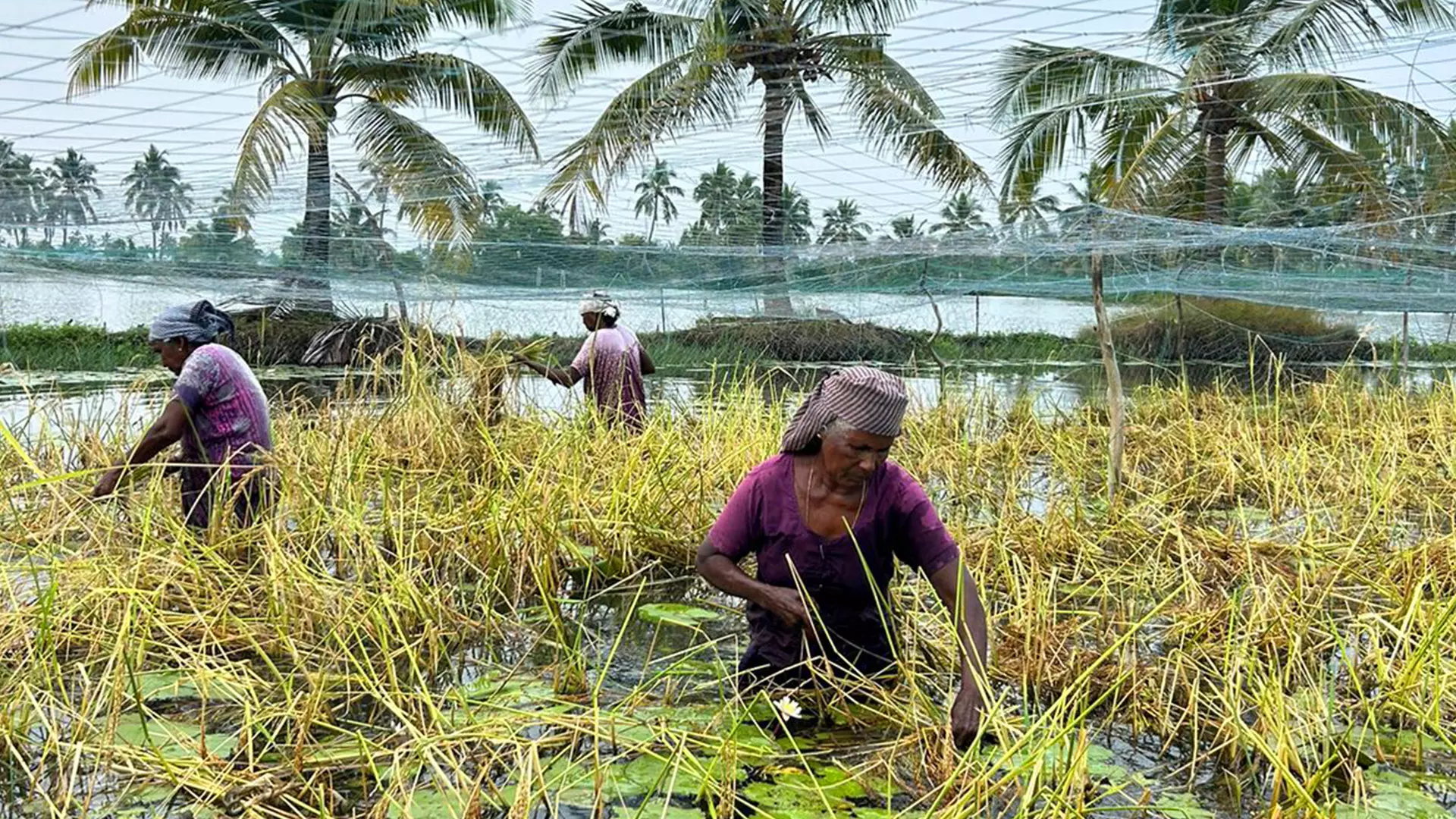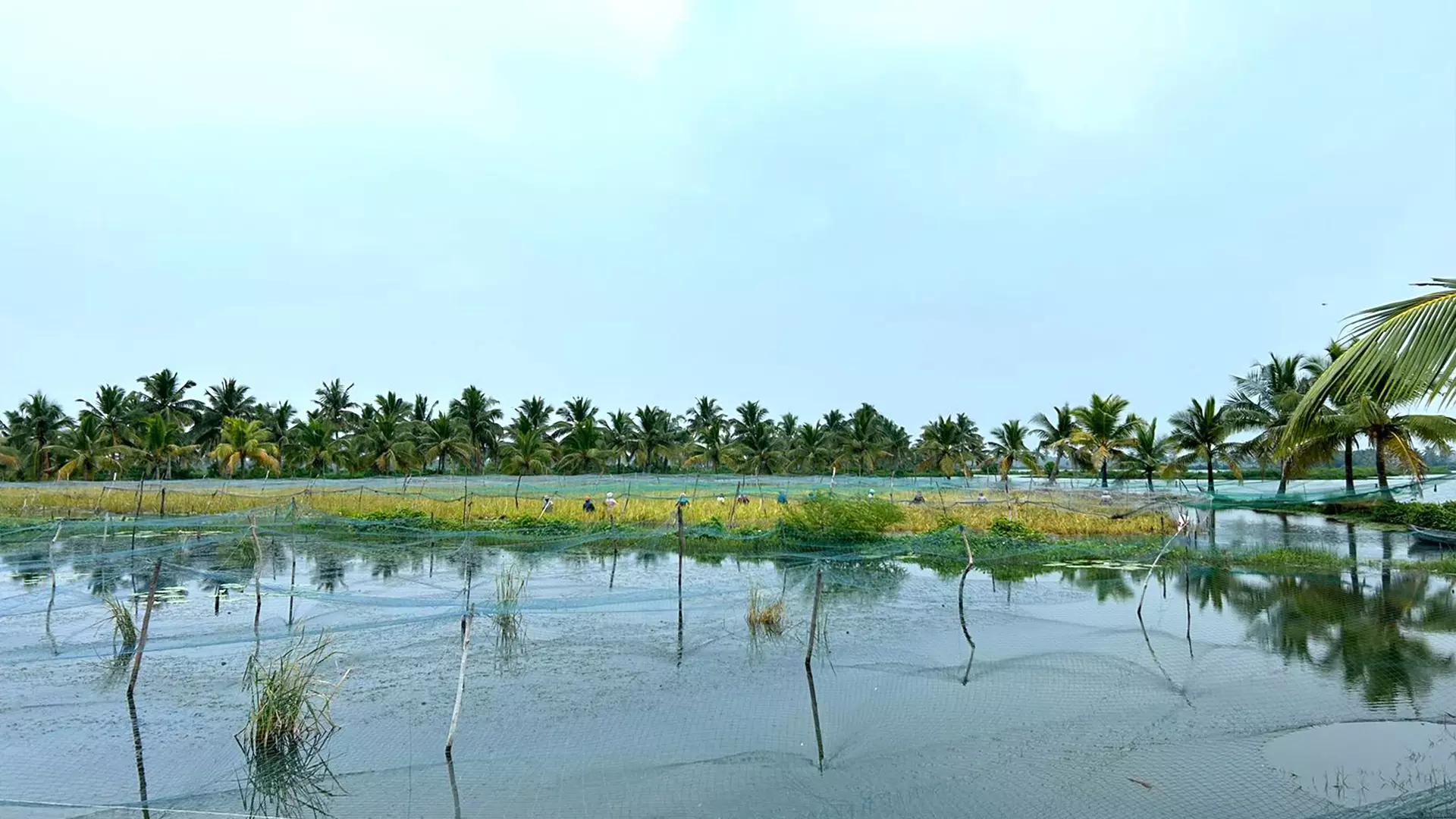
- Home
- India
- World
- Premium
- THE FEDERAL SPECIAL
- Analysis
- States
- Perspective
- Videos
- Sports
- Education
- Entertainment
- Elections
- Features
- Health
- Business
- Series
- In memoriam: Sheikh Mujibur Rahman
- Bishnoi's Men
- NEET TANGLE
- Economy Series
- Earth Day
- Kashmir’s Frozen Turbulence
- India@75
- The legend of Ramjanmabhoomi
- Liberalisation@30
- How to tame a dragon
- Celebrating biodiversity
- Farm Matters
- 50 days of solitude
- Bringing Migrants Home
- Budget 2020
- Jharkhand Votes
- The Federal Investigates
- The Federal Impact
- Vanishing Sand
- Gandhi @ 150
- Andhra Today
- Field report
- Operation Gulmarg
- Pandemic @1 Mn in India
- The Federal Year-End
- The Zero Year
- Science
- Brand studio
- Newsletter
- Elections 2024
- Events
A 76-year-old farmer fights to preserve an ancient paddy farming practice

Wrapped in a blue-coloured lungi, Chanthu Manchadiparambil stood two feet deep in the water in his paddy land with a handful of grains. The paddy grains have lost their golden hues as they grew in the two-foot deep water in the field where the permissible height of water was six inches. The 76-year-old farmer has lost more than 50% of his crops due to breach of a traditional farming practice...
Wrapped in a blue-coloured lungi, Chanthu Manchadiparambil stood two feet deep in the water in his paddy land with a handful of grains. The paddy grains have lost their golden hues as they grew in the two-foot deep water in the field where the permissible height of water was six inches. The 76-year-old farmer has lost more than 50% of his crops due to breach of a traditional farming practice in which timely regulation of water in the pokkali fields is significant.
The pokkali paddy cultivation is an organic saline water farming method practised in three coastal districts of Kerala, namely Ernakulam, Alappuzha and Thrissur for centuries. Pokkali, a traditional saline-tolerant variety of rice, is cultivated in the water-logged areas of the five taluks of these three districts, bordering the Arabian Sea. Chanthu has been cultivating Pokkali in Maruvakkad in Ernakulam district since he retired from service in 2000. The yield was good, and it was profitable. Today, Chanthu is worried as he loses his crops heavily due to poor water management by the prawn contractors in the region.
The cultivation is done during the monsoon, as heavy rains in the months of June-July bring down the salinity levels in the marsh, enabling germination of the pokkali paddy seeds. The marshlands will be converted into paddy fields with bunds and water regulation to and from the adjoining backwaters. The paddy cultivation preserves the natural rain water and backwater water exchange and tidal phenomenon. As it takes seven months for the pokkali rice to mature, the remaining five months are used for the cultivation of fish every year. Pokkali cultivation was going on smoothly until the second half of the 20th century when prawn cultivation by this method gained commercial significance.

Pokkali cultivation is done during the monsoon, as heavy rains in the months of June-July bring down the salinity levels in the marsh, enabling germination of the pokkali paddy seeds.
By the early 21st century, prawn aquaculture started replacing both pokkali and traditional fish cultivation illegally by pushing prawn aquaculture throughout the year by manually holding the highly saline water within the Padashekharams (a group of paddy fields). This has devastated the soil properties, paddy cultivation, vegetable cultivation on the bunds and the ecological balance of the region. The water has to be pumped out completely in the months of March and April, but it is deliberately not done, say activists.
Lack of support and sponsorship brings in hurdles to this traditional paddy cultivation. As many farmers left the cultivation long ago, a few like Chanthu try to swim against the tide. “The district administration and the agriculture department are deliberately making it impractical for farmers to cultivate pokkali in these fields. The aim of the prawn farming lobby and some influential people in the government is to subvert the “one paddy, one fish” policy being prevailed in the region. The authorities have failed repeatedly to regulate the amount of water in the pokkali paddy fields,” he said.
Chanthu knew that he would be losing crops heavily to poor water management when he decided to cultivate pokkali in his field in Maruvakkad in July this year. “A couple of weeks before the actual date of cultivation, I wrote to the district collector and requested him to take initiative to regulate the water in the paddy fields. No action was taken and no one has visited the paddy fields in this region. It was an age-old practice that the water level should be regulated to carry on the pokkali cultivation after the monsoon, but it is not happening today. The ideal water level in the paddy fields should be six inches, but today it is more than two feet. I lost more than half of my crops to water. The government as the legitimate custodian of the sluice regulators connecting water bodies across local government bodies and districts is evading their duty to control water levels in the pokkali paddy lands,” he said.

As it takes seven months for the pokkali rice to mature, the remaining five months are used for the cultivation of fish every year.
The region where once pokkali cultivation was done has shrunk to a large extent mainly due to the arrival of the prawn contractors, who use the pokkali fields for prawn cultivation for the whole year," said Chanthu, who used to sell a kilogram of pokkali rice for Rs 150. “My pokkali fields remained unaffected during the flood that wrecked havoc in Kerala in 2018. It shows the tolerance of this traditional variety during natural disasters.”
While the pokkali rice cultivation is practised during the low saline phase (June to mid-October), the prawn farming is done during the high-saline phase (November to April). Chanthu had filed writ petitions to prevent the contractors from using the Pokkali field for prawn cultivation in 2020 and 2021 at the High Court of Kerala. Under Rule 16 (6) of the Kerala Inland Fisheries and Aquaculture Rules, 2013, the seasonal prawn cultivation period in the Pokkali fields is fixed to be from November 15 to April 14 every year.
When V4 Kochi, a Kochi-based people’s movement, entered the adjoining rural areas as part of political activism and joined Chanthu and 200 odd families of Maruvakkad Padashekharam of Chellannam village in rural Kochi in 2021, the general perception being spread at the behest of fisheries export companies and the highest officials at fisheries department at secretariat, Thiruvananthapuram was that the mildly saline coastal wetland pokkali paddy fields of Kerala can no more practically sustain pokkali paddy cultivation and must be converted into full year around tiger prawn aquaculture water bodies, according to Nipun Cherian, president of V4 Kochi.
“The proposition of year-round prawn cultivation has serious consequences for the coastal population in the districts of Alappuzha, Ernakulam and Thrissur. Apart from the loss of pokkali paddy cultivable land, conversion of the pokkali padashekharams into salt water bodies for year-round prawn cultivation would have devastating effects. The consequences were already visible on the field in 2021 as prawn contractors supported by the export companies and the corrupt fisheries officials were already implementing their 12-month prawn cultivation scheme subverting the six-month-paddy-six-month-fish dual crop policy of the Government of Kerala,” said Cherian who has been fighting legal battles for the pokkali farmers and traditional fishermen in the region. In 2023, the Kerala High Court sentenced him to four months simple imprisonment and a fine of Rs 2000 in a suo motu contempt case for his statements against a sitting judge of the High Court with regard to a judgement passed by him. Cherian underwent four months sentence after he declined to apologise for the same. An appeal that he filed after undergoing the sentence is pending before the Supreme Court.
The high levels of water level maintained for maximum prawn harvest meant that the saline waters entered the households of hundreds of families in the pokkali paddy lands. “The water levels are controlled by sluice regulators at the outer bunds separating paddy-lands and backwaters. The prawn aquaculture interest of preventing the artificially introduced prawn seedlings to be inadvertently caught during the maturing period meant that the prawn contractors would stop local fishermen from traditional fishing practices. The prawn contractors effectively trespass and take control of the public and private shallow water lands and paddy lands in the region for this purpose. The full-year salinity means that the lands become unsuitable for vegetable plants and trees including coconut palms and also destroys freshwater ponds and wells,” he added.
Being a unique variety of rice, pokkali won Geographical Indication (GI) status in 2008-09. Pokkali rice is rich in protein, fiber and antioxidants. It has the lowest concentration of carbohydrates and is also enriched with micronutrients such as iron, sulphur, boron and vitamin E. In “A Study on Farmers Perception on Problems of Pokkali Rice Farming in the State of Kerala”, researchers N Shamna and Vasantha R said this precious culture is encountering immense problems such as acute shortage of farm hands for harvesting, shift to monoculture of prawn farming from rice-prawn farming system and other anthropogenic reasons such as conversion of Pokkali fields for other purposes like roads, bridges, residential or commercial activities and overexploitation of fish and prawns.
K Mukundan, a farmer, said if immediate action is not taken, the pokkali paddy fields will disappear soon. “I think our agriculture department is not interested in preserving traditional methods like the pokkali cultivation. The method is important as it doesn’t need any pesticides,” he said. For farmers like Chanthu, the struggle to regulate water level against the interests of prawn cultivation is not easy. Many have left pokkali cultivation as they face serious threats from illegal prawn farming in the region. “I will not give up pokkali cultivation and it is my duty to preserve this traditional method,” said Chanthu. But how far? "My son will do it after me and that's how we continue the journey," he added.
